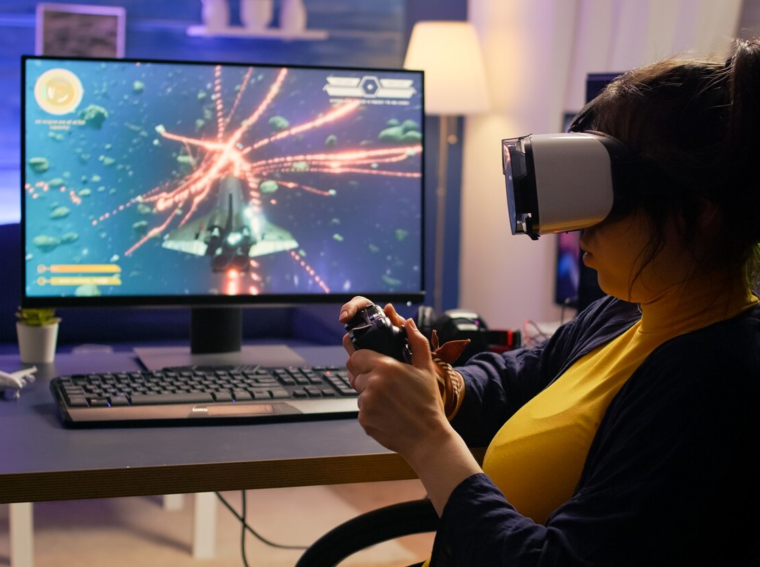Gaming has evolved dramatically over the years thanks to incredible technological advancements. Today, almost everyone plays at least one game, whether on their personal computer or their phone.
Unsurprisingly, the innovations used in gaming make games more fun but also more immersive and realistic. Let’s dive into five cutting-edge technologies that are transforming the gaming world.
Artificial Intelligence (AI)
Artificial Intelligence, or AI, is making games more innovative and engaging. AI is used to create intelligent characters that can adapt to your playing style. It uses data gathered from your preferences and makes knowledgeable suggestions, just like how the algorithm would suggest types of clothing or shoes that you previously clicked on.
For example, you register on an online betting site. At first, the site won’t know what you would prefer, but the longer you watch and bet on sports in New Zealand, for example, the more it will show up on your homepage.
That’s also how it can modify and improve many modern games today; enemies can learn from your actions and change tactics, providing a more challenging and dynamic experience. One notable example is the AI in “The Last of Us Part II.” The game features enemies that communicate with each other, coordinate their attacks, and react realistically to the player’s actions.

This level of intelligence makes the game world feel alive and unpredictable. AI is also used in game development to create more realistic animations, generate complex worlds, and even assist in storytelling by adapting the plot based on player choices.
Virtual Reality (VR)
Virtual Reality, or VR, is revolutionizing the way we experience games. With VR headsets, players can immerse themselves in a fully interactive 3D environment. Imagine putting on a headset and finding yourself inside a fantastical world where you can look around, move, and interact with objects just like in real life. VR uses sensors to track your head and hand movements, making the experience incredibly lifelike.
Games like “Beat Saber” and “Half-Life: Alyx” have shown VR’s power. In “Beat Saber,” players use virtual lightsabers to slash through blocks in time with music, creating a dynamic and physical gaming experience. “Half-Life: Alyx” places you in a detailed, dystopian world where you solve puzzles and fight enemies, feeling like you are genuinely part of the story. VR is pushing the boundaries of how we interact with digital worlds and promises even more exciting developments in the future.
Augmented Reality (AR)
Augmented Reality, or AR, blends the digital and real worlds, adding game elements to your everyday environment. One of the most famous examples of AR is “Pokémon Go.” This game uses your smartphone’s camera and GPS to place virtual Pokémon in real-world locations, encouraging players to explore their surroundings to catch them.
Of course, AR isn’t limited to mobile games; it’s even used in online casino websites where you can experience what the game would be like if you played in person. There are also devices like Microsoft HoloLens and Magic Leap that are expanding the possibilities of AR in gaming.

These headsets overlay digital information onto the real world, allowing for complex interactions. Imagine playing a strategy game where you can lay out your battlefield on your dining room table or solve puzzles that appear on your living room walls. AR makes gaming more interactive and brings digital experiences into our physical space.
Cloud Gaming
Cloud gaming is transforming how we access and play games. Like streaming movies on Netflix, cloud gaming allows you to play games online without needing a powerful console or computer. Google Stadia, NVIDIA GeForce Now, and Xbox Cloud Gaming lets you stream games directly to your devices, including smartphones, tablets, and smart TVs.
The main advantage of cloud gaming is convenience. You can start playing a game on your home TV, continue on your smartphone during your commute, and pick up right where you left off on your laptop. It eliminates the need for physical discs and large downloads, making gaming more accessible and flexible.
As Internet speeds continue to improve, cloud gaming is set to become even more popular, providing high-quality gaming experiences to more people worldwide.
Ray Tracing
Ray tracing is a technology that significantly enhances the visual realism of games. It simulates how light interacts with objects in the real world, creating stunningly realistic lighting, shadows, and reflections. This technology is critical in games that strive for high graphical fidelity.
Games like “Cyberpunk 2077” and “Minecraft” have implemented ray tracing to create breathtaking visual effects. In “Cyberpunk 2077,” ray tracing brings the neon-lit streets of Night City to life with realistic reflections and shadows.
In “Minecraft,” a game known for its simple graphics, ray tracing transforms the world with beautiful, lifelike lighting that makes the blocky landscape look surprisingly natural. Ray tracing requires powerful hardware, but as technology advances, it is becoming more accessible to gamers, making it a key feature in the future of gaming graphics.
Final Thoughts
These five innovative technologies are shaping the future of gaming, but others contribute to its booming success. These technologies make your games more immersive, interactive, and visually stunning.
Every day, there are innovations and technologies that gamers and the commoner can use, and the possibilities for gaming are endless. Get ready to dive into new worlds and experiences because the future of gaming is exhilarating!
